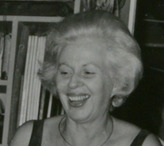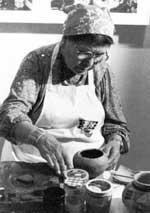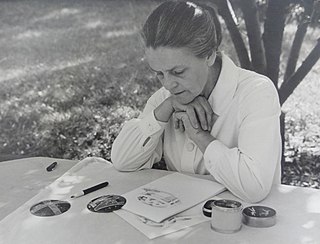Related Research Articles

The Zuni are Native American Pueblo peoples native to the Zuni River valley. The Zuni people today are federally recognized as the Zuni Tribe of the Zuni Reservation, New Mexico, and most live in the Pueblo of Zuni on the Zuni River, a tributary of the Little Colorado River, in western New Mexico, United States. The Pueblo of Zuni is 55 km (34 mi) south of Gallup, New Mexico. The Zuni tribe lived in multi level adobe houses. In addition to the reservation, the tribe owns trust lands in Catron County, New Mexico, and Apache County, Arizona. The Zuni call their homeland Halona Idiwan’a or Middle Place. The word Zuni is believed to derive from the Western Keres language (Acoma) word sɨ̂‧ni, or a cognate thereof.

Elsa Peretti, OMRI OMM, was an Italian jewelry designer and philanthropist as well as a fashion model. Her jewelry and design pieces for Tiffany & Co. are included in the 20th century collection of the British Museum, the Museum of Fine Arts, Boston and the Museum of Fine Arts, Houston. In 1974 Peretti, the "Halstonette" fashion model arrived at Tiffany's with her modern jewelry. Her broadly popular work, including pieces like Bean, Bone Cuff and Open Heart, became as much as 10% of Tiffany's business and John Loring's Tiffany Style – 170 Years of Design devotes 18 pages of images to her jewelry and tableware design. Vogue described her as "arguably the most successful woman ever to work in the jewelry field." As a philanthropist, Peretti supported a wide variety of causes, and also privately undertook the restoration of the historic village of Sant Martí Vell in Catalonia, Spain.

Fred Kabotie was a celebrated Hopi painter, silversmith, illustrator, potter, author, curator and educator. His native name in the Hopi language is Naqavoy'ma which translates to Day After Day.
Della Casa is a surname. Notable people with the surname include:

Native American jewelry refers to items of personal adornment, whether for personal use, sale or as art; examples of which include necklaces, earrings, bracelets, rings and pins, as well as ketohs, wampum, and labrets, made by one of the Indigenous peoples of the United States. Native American jewelry normally reflects the cultural diversity and history of its makers, but tribal groups have often borrowed and copied designs and methods from other, neighboring tribes or nations with which they had trade, and this practice continues today. Native American tribes continue to develop distinct aesthetics rooted in their personal artistic visions and cultural traditions. Artists may create jewelry for adornment, ceremonies, and display, or for sale or trade. Lois Sherr Dubin writes, "[i]n the absence of written languages, adornment became an important element of Indian communication, conveying many levels of information." Later, jewelry and personal adornment "...signaled resistance to assimilation. It remains a major statement of tribal and individual identity."

The Millicent Rogers Museum is an art museum in Taos, New Mexico, founded in 1956 by the family of Millicent Rogers. Initially the artworks were from the multi-cultural collections of Millicent Rogers and her mother, Mary B. Rogers, who donated many of the first pieces of Taos Pueblo art. In the 1980s, the museum was the first cultural organization in New Mexico to offer a comprehensive collection of Hispanic art.

Art of the American Southwest is the visual arts of the Southwestern United States. This region encompasses Arizona, New Mexico, and parts of California, Colorado, Nevada, Texas, and Utah. These arts include architecture, ceramics, drawing, filmmaking, painting, photography, sculpture, printmaking, and other media, ranging from the ancient past to the contemporary arts of the present day.
Carolyn L. Mazloomi is an American curator, quilter, author, art historian, and aerospace engineer. She is a strong advocate for presenting and documenting African-American-made quilts. Her own quilts are designed to tell complex stories around African-American heritage and contemporary experiences.
Allen Raj was a Hopi artist and silversmith in Hopi silver overlay and stone inlay, featuring the lapidary genres of commesso and intarsia. Sekaquaptewa used colorful stones and shell for his Hopi silver overlay, not only plain silver decorated with chisel strokes on black oxide surfaces, a Hopi-signature technique known as matting.

Catherine Elizabeth Cooke is an American designer whose career has lasted more than 73 years. She is principally known for her jewelry. She has been called "an icon within the tradition of modernist jewelry" and "a seminal figure in American Modernist studio jewelry". Her pieces have been shown nationally and internationally and are included in a number of museum collections, including the Museum of Modern Art (MOMA) in New York. She is regarded as an important role model for other artists and craftspeople.

Alma Rosalie Eikerman was an American metalsmith, silversmith, and jewelry designer who was instrumental in building the metals program at Indiana University, of which she retired Distinguished Professor Emeritus. She was a founding member of the Society of North American Goldsmiths and studied under several internationally renowned metalsmiths, such as Karl Gustav Hansen. Eikerman's work has appeared in over 200 exhibitions, including Objects: USA at the Smithsonian Institution.

Winifred Mason was an African-American jeweler who was active in New York during the 1940s. She worked primarily in copper, and was inspired by West Indian cultural traditions. She is believed to be the first commercial African-American jeweler in the United States.
Denise Wallace is a Native American jeweler and member of the Sugpiaq tribe.
Susan Billy is a Native American Pomo basket weaver from the Hopland Band Pomo Indians of Northern California.

Daisy Hooee Nampeyo was a Hopi-Tewa potter. She studied at École des Beaux-Arts. Hooee taught pottery making on the Zuni reservation and helped preserve the traditional techniques she learned from her grandmother, Nampeyo.
Grace Hazen (1874-1940) was an American jewelry designer who founded the Hazen Crafts School at Rocky Neck, East Gloucester, Massachusetts. She specialized in hand-wrought jewelry.
Marilyn da Silva is an American sculptor, metalsmith, jeweler, and educator. She teaches and serves as a department head at the California College of the Arts in the San Francisco Bay Area. Da Silva has won numerous awards including honorary fellow by the American Craft Council (2007).

Margarete Seeler (1909–1996) was a German-born American artist, designer, educator, and author. She was known for work as a goldsmith, her enamelwork, graphic design, and her paintings. She was one of the best known enamelers in the United States, specifically for her cloisonné work. She published two books on enameling, The Art of Enameling (1969) and Enamel Medium for Fine Art (1997). Seeler was elected as a Fellow of the American Craft Council in 1993.
Effie C. Calavaza was a Native American Zuni jewelry artist.
Edith Bondie (1918-2005) was a basketmaker whose work is in the Smithsonian Institution, the Eiteljorg Museum of American Indians and Western Art, and the Besser Museum for Northeast Michigan.
References
- ↑ Greenbaum, Toni; Kirkham, Pat (2000). "Women Jewelry Designers". In Kirkham, Pat (ed.). Women Designers in the USA, 1900-2000: Diversity and Difference. New Haven, CT: Yale University Press. pp. 202–203. ISBN 0300087349.
- ↑ "Della Casa (Casi) Appa Zuni Silversmith". Sedona Indian Jewelry. Retrieved 2017-10-06.
- ↑ Elizabeth Hardin-Burrola; Carol Sarath; Bob Rosebrough (31 July 2017). Legendary Locals of Gallup. Arcadia Publishing Incorporated. p. 45. ISBN 978-1-4396-6344-8.
- ↑ The Museum of Indian Arts and Culture related site